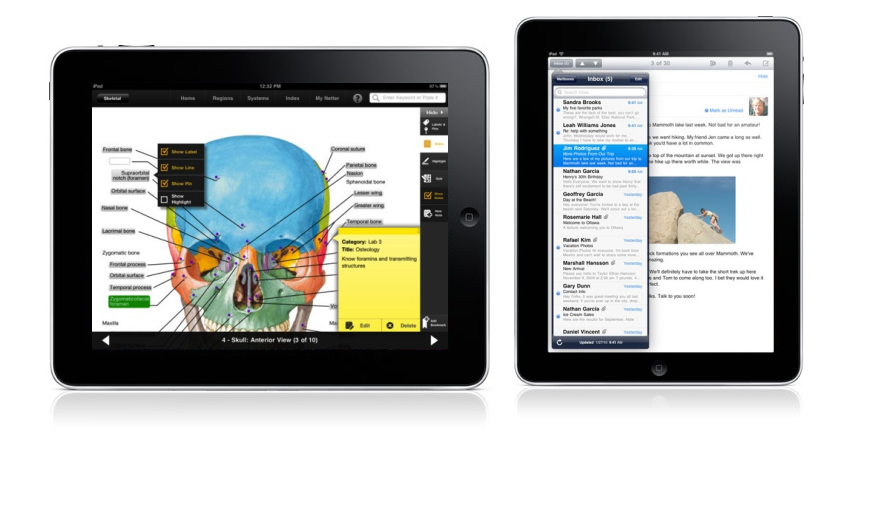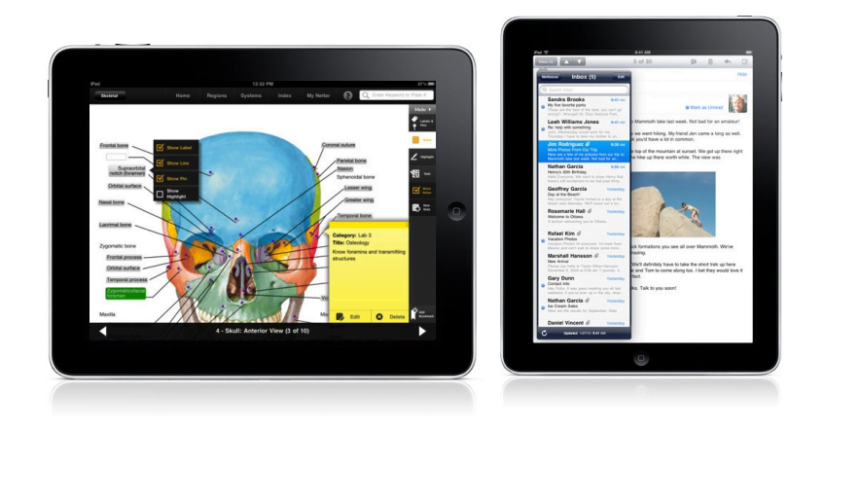iPad has revolutionized our lives in a phenomenal way. Be it booking movie tickets, cooking favorite recipes, or learning music, there is an app for virtually every situation imaginable. While many industries and professional from diverse backgrounds have embraced iPad apps, its features and raw power, the healthcare industry has been relatively slow to adopt this technology. There are many reasons for the slow adoption rate such as credibility of apps, stringent laws protecting privacy of patient information, and relatively weak integration with backend systems.
iPad has revolutionized our lives in a phenomenal way. Be it booking movie tickets, cooking favorite recipes, or learning music, there is an app for virtually every situation imaginable. While many industries and professional from diverse backgrounds have embraced iPad apps, its features and raw power, the healthcare industry has been relatively slow to adopt this technology. There are many reasons for the slow adoption rate such as credibility of apps, stringent laws protecting privacy of patient information, and relatively weak integration with backend systems.
However, winds of change and transformation have finally struck the healthcare industry which has witnessed exponential growth in medical apps over the last few years. The ever growing influence of Bring Your Own Device (BYOD) phenomena, as well as significant increase in the use of iPad and smartphones by doctors, patients, pharmacies, and vendors have contributed to the change in the healthcare sector. Healthcare industry is finally beginning to accept and evolve with the App revolution.
iPad Healthcare App: Is it the new standard?
Today, there are many healthcare and related apps available for a wide range of functions from treatment and monitoring to accessing test results or information about disease. Physicians can access symptoms, medical calculators and more via tablet apps. Patients use apps to locate doctors or monitor chronic diseases. The iPad has spearheaded a new BYOD phenomena in the healthcare sector. It allows medical professionals to work on a device of their choice taking patient engagement to the next level.
Gone are the primitive days when healthcare professionals accessed information from either desktop or laptop. The iPad has facilitated innovative patient/doctor communication methods. According to research study, 500 million smartphone users worldwide will be using a healthcare application by 2015. What has triggered this increase in numbers? One possible reason could be that healthcare professionals are no longer staying oblivious to the fact that iPad apps can have lasting effect on patient care and safety, improving efficiency of the system, and reducing costs. Healthcare apps provide a comprehensive overview of clinical guidelines, update information which could facilitate decision making by medical professionals. This extent of accessibility has its own pros and cons–but has proven to be beneficial in the healthcare sector.

Advantages of iPad healthcare apps
- Patient Safety and care
More and more patients are using apps to monitor and mange their health. Imagine if you had all information in an app rather than voluminous files. An app that alerts you to take your medicine dose on time as prescribed by your doctor or reminds of you of your monthly appointments. It would be so convenient if your informed you are running low on pills and need refill. Physicians and healthcare professionals can improve patient care by automation of procedures and work flow. - Easy access to information
Tablets provide quick access to information wherever healthcare personnel need it from anywhere. The sheer portability of the devices’ makes it easier to assimilate information to the patient. - Increases efficiency
iPad helps eliminate or minimize cumbersome paperwork as well as duplication of work involved in recording information on paper and entering into systems. This saves time, resources, energy, money and improves overall efficiency of the process. Also, no to mention eliminating possibility of human error. - Minimizes costs
The use of healthcare apps streamlines patient information resulting in a reduction of errors (both diagnostic and treatment) and ultimately saving money for healthcare facilities. - Effective use of audio, video, visual communication modes
The effective use of multimedia and graphic modes can be effectively utilized to record and provide information such as the visual images of a patient, disease progression and sounds. Many physicians use this information to keep up-to-date with clinical information. Video communication can also be used.
iPad Applications: Challenges and bottlenecks
- Not always accurate and consistent
Textbooks undergo rigorous review before being published by experts. But apps by dubious developers fluctuate in quality and might not always meet accuracy or safety standards. These apps can be dangerous for patients in case technical glitches have not been solved during the development phase. No matter how much an app developer tries to create a error free healthcare app, one can never be sure until it has actually been developed and ultimately deployed. - Security and confidentiality
There is no doubt that the use of iPad applications are on the rise. However, there is rising concern about security. Do healthcare organizations take preventive measures towards misuse? Do they have proper policy for security of mobile assets. This aspect is crucial and should not be overlooked.
- Regulatory challenges
Beyond the thousands and thousands of medical apps for tablets and smartphones available, there are apps being developed that will be governed by the FDA regulations. The approval process can be excruciatingly long and might take months.
List of top iPad healthcare applications
- Medscape
With more than 3 million healthcare professionals using this app, Medscape is one of the pioneering medical resources used extensively by physicians, students, nurses and other medico professionals to gain clinical information. It provides medical news and critical alerts for 34 specialty areas. It allows easy search of medication and descriptions of diseases, conditions and procedures. Medscape has calculators for 129 medical formulas, classifications, and scales. The latest version provides additional feature of viewing all drugs in a particular class. - MedPage Today Mobile
MedPage Today Mobile puts breaking medical news, as well as all-encompassing reference information and FREE CME/CE credits. It provides daily coverage of 30+ specialties and annual coverage of more than 60 meetings and symposia. - AHRQ ePSS
The Electronic Preventive Services Selector (ePSS) is an app designed and developed by the U.S. Department of Health & Human Services (HHS), Agency for Healthcare Research and Quality (AHRQ). This app assists primary care clinicians by providing necessary information about screening, counseling, and preventive medication services appropriate for patients. - Radiology 2.0: One Night in the ED
This is an instructional iPad app for educational radiology programs. Radiology 2.0 is a series of cases that allow user to simulate reading CT scans at a PACS workstation. All of the extensive content is contained within the app for offline viewing. - Calculate (Medical Calculator) by QxMD
Calculate is a next-generation clinical calculator and decision support tool, freely available to the medical community. It is developed by an extensive collaboration of clinician experts from diverse backgrounds. Calculate provides point-of-care tools in diverse areas including, but not limited to cardiology, internal medicine, nephrology, general practice, hematology, and gastroenterology.
Conclusion:
iPad apps are meeting increasingly sophisticated needs of both healthcare professionals and patients. These apps range from patient information dashboards to critical news to educational apps. This is not it there are apps for scheduling appointments or reminding you to refill your medicines. Healthcare app are transcending limits and providing better patient care. However, healthcare apps can never replace traditional doctor-patient relationship. Since healthcare apps are extremely sensitive, it is developer’s responsibility to rigorously test app. Quality compromises could be costly. It is equally important that user conducts a thorough due diligence of app such as checking developer’s bio, user feedback, and its reputation on the net before actually installing/using it.






